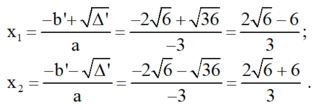4x2 + 14x + 11= 4\(\sqrt{6x=10}\)

Những câu hỏi liên quan
giải phương trình:
a,\(\left(\sqrt{1+x}+1\right)\left(\sqrt{1+x}+2x-5\right)=x\)
b, \(4\sqrt{6x+10}=4x^2+14x+11\)
a.
ĐKXĐ: \(x\ge-1\)
\(\Leftrightarrow\left(\sqrt{x+1}+1\right)\left(\sqrt{x+1}+2x-5\right)=x+1-1\)
\(\Leftrightarrow\left(\sqrt{x+1}+1\right)\left(\sqrt{x+1}+2x-5\right)=\left(\sqrt{x+1}+1\right)\left(\sqrt{x+1}-1\right)\)
\(\Leftrightarrow\sqrt{x+1}+2x-5=\sqrt{x+1}-1\)
\(\Leftrightarrow2x-5=-1\)
\(\Leftrightarrow x=2\)
Đúng 1
Bình luận (0)
b.
ĐKXĐ: \(x\ge-\dfrac{5}{3}\)
\(6x+10+4\sqrt{6x+10}+4=4x^2+20x+25\)
\(\Leftrightarrow\left(\sqrt{6x+10}+4\right)^2=\left(2x+5\right)^2\)
\(\Leftrightarrow\left[{}\begin{matrix}\sqrt{6x+10}+4=2x+5\\\sqrt{6x+10}+4=-2x-5\end{matrix}\right.\)
\(\Leftrightarrow\left[{}\begin{matrix}\sqrt{6x+10}=2x+1\left(1\right)\\\sqrt{6x+10}=-2x-9< 0\left(loại\right)\end{matrix}\right.\)
(1) \(\Leftrightarrow6x+10=4x^2+4x+1\) \(\left(x\ge-\dfrac{1}{2}\right)\)
\(\Leftrightarrow4x^2-2x-9=0\)
\(\Rightarrow x=\dfrac{1+\sqrt{37}}{4}\)
Đúng 1
Bình luận (1)
Phương pháp 6. Biến đổi về dạng \(A^2=B^2\)
a \(x^2+4\sqrt{x+3}=3x+6\)
b \(4x^2+14x+11=4\sqrt{6x+10}\)
c \(4\sqrt{x+1}=x^2-5x+14\)
a) ĐKXĐ : \(x\ge-3\)\(pt\Leftrightarrow x^2-2x+1=x+3-4\sqrt{x+3}+4\Leftrightarrow\left(x-1\right)^2=\left(\sqrt{x+3}-2\right)^2\Leftrightarrow x-1=\sqrt{x+3}-2\Leftrightarrow x+1=\sqrt{x+3}\Leftrightarrow\left(x+1\right)^2=x+3\left(x\ge-1\right)\Leftrightarrow x^2+2x+1=x+3\Leftrightarrow x^2+x-2=0\Leftrightarrow\left[{}\begin{matrix}x=1\left(tmdk\right)\\x=-2\left(kotm\right)\end{matrix}\right.\)
Đúng 1
Bình luận (1)
Gpt: 4x² +14x +11 =4√(6x +10).
Giải PT: \(4x^2+14x+14=4\sqrt{6x+10}\)
Xác định a, b, c rồi dùng công thức nghiệm thu gọn giải các phương trình:
a
)
4
x
2
+
4
x
+
1
0
b
)
13852
x
2
−...
Đọc tiếp
Xác định a, b', c rồi dùng công thức nghiệm thu gọn giải các phương trình:
a ) 4 x 2 + 4 x + 1 = 0 b ) 13852 x 2 − 14 x + 1 = 0 c ) 5 x 2 − 6 x + 1 = 0 d ) − 3 x 2 + 4 6 ⋅ x + 4 = 0
a) Phương trình bậc hai 4 x 2 + 4 x + 1 = 0
Có a = 4; b’ = 2; c = 1; Δ ’ = ( b ’ ) 2 – a c = 2 2 – 4 . 1 = 0
Phương trình có nghiệm kép là:

b) Phương trình 13852 x 2 – 14 x + 1 = 0
Có a = 13852; b’ = -7; c = 1;
Δ ’ = ( b ’ ) 2 – a c = ( - 7 ) 2 – 13852 . 1 = - 13803 < 0
Vậy phương trình vô nghiệm.
c) Phương trình bậc hai 5 x 2 – 6 x + 1 = 0
Có: a = 5; b’ = -3; c = 1.; Δ ’ = ( b ’ ) 2 – a c = ( - 3 ) 2 – 5 . 1 = 4 > 0
Phương trình có hai nghiệm phân biệt:

d) Phương trình bậc hai: ![]()

Phương trình có hai nghiệm phân biệt :

Kiến thức áp dụng
Phương trình ax2 + bx + c = 0 (a ≠ 0) có biệt thức Δ = b2 – 4ac.
+ Nếu Δ > 0, phương trình có hai nghiệm phân biệt 
+ Nếu Δ = 0, phương trình có nghiệm kép  ;
;
+ Nếu Δ < 0, phương trình vô nghiệm.
Đúng 0
Bình luận (0)
\(\sqrt{2x+11}+\sqrt{x-1}\) ; \(\dfrac{\sqrt{-5x}}{x}\) ; \(\dfrac{\sqrt{7x^2+1}}{5}\); \(\sqrt{x^2-14x+33}\); \(\dfrac{\sqrt{-x^2+6x+16}}{-2}+\dfrac{x^2-2x}{3x^2}\)
Tìm ĐKXĐ của x để các biểu thức trên có nghĩa
a: ĐKXĐ: \(x\ge1\)
b: ĐKXĐ: \(x< 0\)
c: ĐKXĐ: \(\left[{}\begin{matrix}x\ge11\\x\le3\end{matrix}\right.\)
Đúng 0
Bình luận (0)
1) ĐKXĐ: \(\left\{{}\begin{matrix}2x+11\ge0\\x-1\ge0\end{matrix}\right.\)\(\Leftrightarrow x\ge1\)
2) ĐKXĐ: \(\left\{{}\begin{matrix}-5x\ge0\\x\ne0\end{matrix}\right.\)\(\Leftrightarrow x< 0\)
3) ĐKXĐ: \(7x^2+1\ge0\left(đúng\forall x\right)\Leftrightarrow x\in R\)
4) ĐKXĐ: \(x^2-14x+33\ge0\Leftrightarrow\left(x-11\right)\left(x-3\right)\ge0\)
\(\Leftrightarrow\left[{}\begin{matrix}\left\{{}\begin{matrix}x-11\ge0\\x-3\ge0\end{matrix}\right.\\\left\{{}\begin{matrix}x-11\le0\\x-3\le0\end{matrix}\right.\end{matrix}\right.\)\(\Leftrightarrow\left[{}\begin{matrix}x\ge11\\x\le3\end{matrix}\right.\)
5) ĐKXĐ:
+) \(-x^2+6x+16\ge0\)
\(\Leftrightarrow-\left(x^2-6x+9\right)+25\ge0\)
\(\Leftrightarrow\left(x-3\right)^2\le25\Leftrightarrow-5\le x-3\le5\)
\(\Leftrightarrow-2\le x\le8\)
+) \(3x^2\ne0\Leftrightarrow x\ne0\)
\(\Rightarrow\left\{{}\begin{matrix}-2\le x\le8\\x\ne0\end{matrix}\right.\)
Đúng 1
Bình luận (0)
Dạ mọi ngườii giúp em bài này với ah. Dạ em cảm ơn ạ
\(\left(2\sqrt[3]{x-1}+\sqrt[3]{27-14x}\right)^3=1\)
\(\sqrt{x-2}+\sqrt{4-x}=x^2-6x+11\)
a/
Đặt \(\left\{{}\begin{matrix}\sqrt[3]{x-1}=a\\\sqrt[3]{27-14x}=b\end{matrix}\right.\) ta được hệ:
\(\left\{{}\begin{matrix}2a+b=1\\14a^3+b^3=13\end{matrix}\right.\) \(\Leftrightarrow\left\{{}\begin{matrix}b=1-2a\\14a^3+b^3=13\end{matrix}\right.\)
\(\Rightarrow14a^3+\left(1-2a\right)^3=13\)
\(\Leftrightarrow a^3+2a^2-a-2=0\)
\(\Leftrightarrow\left(a-1\right)\left(a+1\right)\left(a+2\right)=0\)
\(\Leftrightarrow\left[{}\begin{matrix}x-1=1\\x-1=-1\\x-1=-8\end{matrix}\right.\) \(\Leftrightarrow...\)
b/ ĐKXĐ: ...
\(VT=\sqrt{x-2}+\sqrt{4-x}\le\sqrt{2\left(x-2+4-x\right)}=2\)
\(VP=\left(x-3\right)^2+2\ge2\)
Đẳng thức xảy ra khi và chỉ khi \(x=3\)
Bài 2 Phân tích thành nhân tửa) 3x2 – 7x – 10b) x2 + 6x +9 – 4y2c) x2 – 2xy + y2 – 5x + 5y’d) 4x2 – y2 – 6x + 3ye) 1 – 2a + 2bc + a2 – b2 – c2 f) x3 – 3x2 – 4x + 12g) x4 + 64h) x4 – 5x2 + 4i) (x+1)(x+3)(x+5)(x+7) + 16j) (x2 + 6x +8)( x2 + 14x + 48) – 9k) ( x2 – 8x + 15)(x2 – 16x + 60) – 24x2l) 4( x2 + 15x + 50)(x2 +18x +72) – 3x2 Bài 3 tìm gtnnA 9x2 – 6x + 2B 4x2 + 5x + 10C x2 – x + 10D 4x2 + 3x + 20E x2 + y2 – 6xy + 10y + 35F x2 + y2 – 6x + 4y +2M 2x2 + 4y2 – 4xy – 4x – 4y +2021
Đọc tiếp
Bài 2 Phân tích thành nhân tử
a) 3x2 – 7x – 10
b) x2 + 6x +9 – 4y2
c) x2 – 2xy + y2 – 5x + 5y’
d) 4x2 – y2 – 6x + 3y
e) 1 – 2a + 2bc + a2 – b2 – c2
f) x3 – 3x2 – 4x + 12
g) x4 + 64
h) x4 – 5x2 + 4
i) (x+1)(x+3)(x+5)(x+7) + 16
j) (x2 + 6x +8)( x2 + 14x + 48) – 9
k) ( x2 – 8x + 15)(x2 – 16x + 60) – 24x2
l) 4( x2 + 15x + 50)(x2 +18x +72) – 3x2
Bài 3 tìm gtnn
A = 9x2 – 6x + 2
B = 4x2 + 5x + 10
C = x2 – x + 10
D = 4x2 + 3x + 20
E = x2 + y2 – 6xy + 10y + 35
F= x2 + y2 – 6x + 4y +2
M= 2x2 + 4y2 – 4xy – 4x – 4y +2021
Bài 2:
a) \(3x^2-7x-10=\left(x+1\right)\left(3x-10\right)\)
b) \(x^2+6x+9-4y^2=\left(x+3\right)^2-\left(2y\right)^2=\left(x+3-2y\right)\left(x+3+2y\right)\)
c) \(x^2-2xy+y^2-5x+5y=\left(x-y\right)^2-5\left(x-y\right)=\left(x-y\right)\left(x-y-5\right)\)
d) \(4x^2-y^2-6x+3y=\left(2x-y\right)\left(2x+y\right)-3\left(2x-y\right)=\left(2x-y\right)\left(2x+y-3\right)\)
e) \(1-2a+2bc+a^2-b^2-c^2=\left(a-1\right)^2-\left(b-c\right)^2=\left(a-1-b+c\right)\left(a-1+b-c\right)\)
f) \(x^3-3x^2-4x+12=\left(x+2\right)\left(x-3\right)\left(x-2\right)\)
g) \(x^4+64=\left(x^2+8\right)^2-16x^2=\left(x^2+8-4x\right)\left(x^2+6+4x\right)\)h) \(x^4-5x^2+4=\left(x+2\right)\left(x+1\right)\left(x-1\right)\left(x-2\right)\)
i) \(\left(x+1\right)\left(x+3\right)\left(x+5\right)\left(x+7\right)+16=\left(x^2+8x+7\right)\left(x^2+8x+15\right)+16=\left(x^2+8x+7\right)^2+8\left(x^2+8x+7\right)+16=\left(x^2+8x+11\right)^2\)
Đúng 2
Bình luận (0)
a: \(3x^2-7x-10\)
\(=3x^2+3x-10x-10\)
\(=\left(x+1\right)\left(3x-10\right)\)
b: \(x^2+6x+9-4y^2\)
\(=\left(x+3\right)^2-4y^2\)
\(=\left(x+3-2y\right)\left(x+3+2y\right)\)
c: \(x^2-2xy+y^2-5x+5y\)
\(=\left(x-y\right)^2-5\left(x-y\right)\)
\(=\left(x-y\right)\left(x-y-5\right)\)
Đúng 0
Bình luận (0)
a) 3x2−7x−10=(x+1)(3x−10)3x2−7x−10=(x+1)(3x−10)
b) x2+6x+9−4y2=(x+3)2−(2y)2=(x+3−2y)(x+3+2y)x2+6x+9−4y2=(x+3)2−(2y)2=(x+3−2y)(x+3+2y)
c) x2−2xy+y2−5x+5y=(x−y)2−5(x−y)=(x−y)(x−y−5)x2−2xy+y2−5x+5y=(x−y)2−5(x−y)=(x−y)(x−y−5)
d) 4x2−y2−6x+3y=(2x−y)(2x+y)−3(2x−y)=(2x−y)(2x+y−3)4x2−y2−6x+3y=(2x−y)(2x+y)−3(2x−y)=(2x−y)(2x+y−3)
e) 1−2a+2bc+a2−b2−c2=(a−1)2−(b−c)2=(a−1−b+c)(a−1+b−c)1−2a+2bc+a2−b2−c2=(a−1)2−(b−c)2=(a−1−b+c)(a−1+b−c)
f) x3−3x2−4x+12=(x+2)(x−3)(x−2)x3−3x2−4x+12=(x+2)(x−3)(x−2)
g) x4+64=(x2+8)2−16x2=(x2+8−4x)(x2+6+4x)x4+64=(x2+8)2−16x2=(x2+8−4x)(x2+6+4x)h) x4−5x2+4=(x+2)(x+1)(x−1)(x−2)x4−5x2+4=(x+2)(x+1)(x−1)(x−2)
i) (x+1)(x+3)(x+5)(x+7)+16=(x2+8x+7)(x2+8x+15)+16=(x2+8x+7)2+8(x2+8x+7)+16=(x2+8x+11)2(x+1)(x+3)(x+5)(x+7)+16=(x2+8x+7)(x2+8x+15)+16=(x2+8x+7)2+8(x2+8x+7)+16=(x2+8x+11)2
Đúng 1
Bình luận (0)
Bài 4: Tính giá trị biểu thức
M=(7-2x)(4x2+14x+49)-(64-8x3)tại x=1
P =(2x-1)(4x2-2x+1)-(1-2x)(1+2x+4x2) tại x=10
giúp mình với cần gấppppppppppppppppp,pleaseeeeeeeee
\(M=343-8x^3-64+8x^3=279\\ N=8x^3-1-1+8x^3=16x^3=16\cdot1000=16000\)
Đúng 0
Bình luận (2)
\(M=343-8x^3-\left(64-8x^3\right)=343-64=279\)
(biểu thức này ko phụ thuộc vào biến x nên ko cần thay)
\(N=8x^3-1-1+8x^3=16x^3\)
Thay \(x=10\)
\(N=16\cdot10^3=16\cdot1000=16000\)
Đúng 1
Bình luận (0)




















